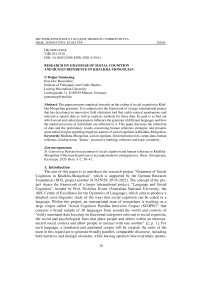Research on grammar of social cognition and human reference in Khalkha-Mongolian
Автор: Dolgor Guntsetseg
Статья в выпуске: 4, 2020 года.
Бесплатный доступ
This paper presents empirical research on the coding of social cognition in Khalkha-Mongolian grammar. It is conducted in the framework of a larger international project that has developed an innovative field elicitation tool that yields natural spontaneous and interactive speech data as well as analysis methods for these data. Its goal is to find out which social and cultural parameters influence the grammar of different languages and how the mental processes of individuals are reflected in it. This paper discusses the collection of data and the preliminary results concerning human reference strategies and presents some initial insights regarding linguistic aspects of social cognition in Khalkha-Mongolian
Khalkha-Mongolian, social cognition, field elicitation tool, corpus data, human reference, kinship terms, ‘kintax’, possessive marking, reference and topic continuity
Короткий адрес: https://sciup.org/148316090
IDR: 148316090 | УДК: 821.5120 | DOI: 10.18101/2305-459X-2020-4-30-41
Список литературы Research on grammar of social cognition and human reference in Khalkha-Mongolian
- 1.Barth, D., Evans, N., San Roque, L., Mansfield, J., Gipper, S., Hodge, G., Rumsey, A., Arka, I.W., Bergqvist, H., Dickson, G., Döhler, C., Eka Pratiwi, I. D. P., Forker, D., Gast, V., Guntsetseg, D., Kashima, E., Kelly, B., Kimoto, Y., Knuchel, D., Kogura, N., Kurabe, K., Narrog H., Schalley, A. C., Schnell, S., Senge, C., Skrib-nik, E. and van Putten, S. (submitted). Frequency and grammar: The case of kinship.
- 2.Barth, D. and Evans, N. (2017): SCOPIC Design and Overview. In: D. Barth and N. Evans (Eds.), LD&C Special Publication No. 12: The Social Cognition Parallax Interview Corpus (SCOPIC): A Cross-linguistic Resource, 1–23.
- 3.Brosig, B. (2019): Terms of address and self-reference in Ulaanbaatar Mongolian. In: Bettina Kluge & María Irene Moyna (eds.) It's not all about 'you' — New perspectives on address research. Topics in address research 1. Amsterdam: Benjamins: 415–433.
- 4.Evans, N. (2010): Dying words: Endangered languages and what they have to tell us. Wiley-Blackwell, Chichester UK.
- 5.Frith, C. D. and Frith, U. (2007): Social cognition in humans. Current Biology 17. R724–R732.
- Givón, T. (1983): Topic continuity in discourse. A quantitative cross-language study. John Benjamins.
- 7.Guntsetseg, D. (2016): Differential case marking in Mongolian. Tunguso-Sibirica, Band 39. Wiesbaden: Harrasowitz Verlag.
- 8.Hasegawa, N. (1985): On the so-called “zero pronouns” in Japanese. The Linguistic Review 4, 289–341.
- 9.Huang, J. C.-T. (1984): On the distribution and reference of empty pronouns. Linguistic Inquiry 15 (4), 531–574.
- San Roque L., Gawne, L., Hoenigman, D., Miller, J.C., Rumsey, A., Spronck, S., Carroll, A. and Evans, N. (2012): Getting the story straight: Language fieldwork using a narrative problem-solving task. Language documentation and conservation 6, 135–174.
- Sloetjes, H. and Wittenburg. P. 2008: Annotation by category — ELAN and ISO DCR. 6th International Conference on Language Resources and Evaluation (LREC 2008).


